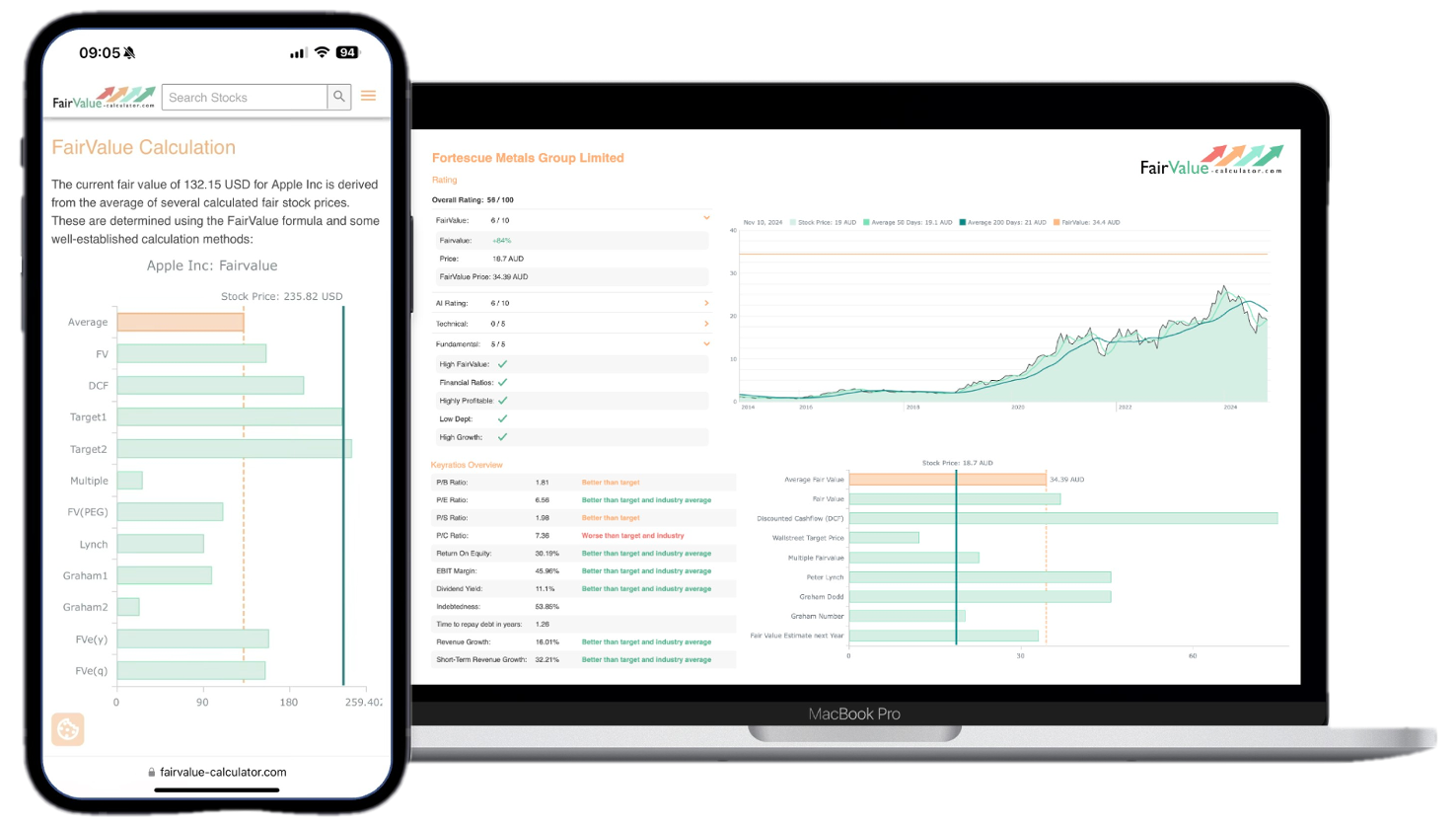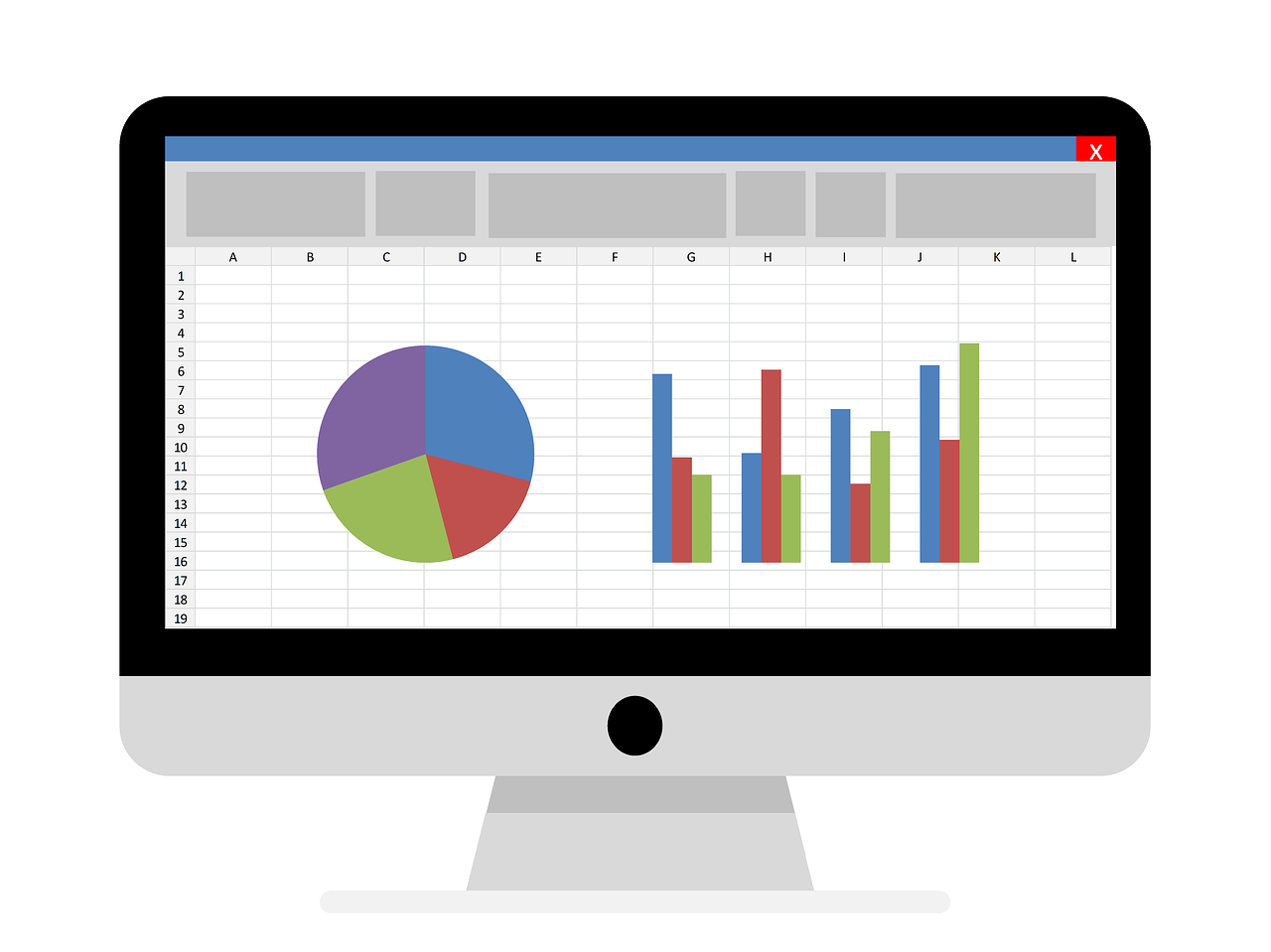When it comes to determining what a stock is truly worth, investors face a fundamental choice between different valuation methodologies. The debate between DCF vs fair value approaches has divided financial professionals for decades, with passionate advocates on both sides arguing for their preferred method’s superiority.
💡 Discover Powerful Investing Tools
Stop guessing – start investing with confidence. Our Fair Value Stock Calculators help you uncover hidden value in stocks using time-tested methods like Discounted Cash Flow (DCF), Benjamin Graham’s valuation principles, Peter Lynch’s PEG ratio, and our own AI-powered Super Fair Value formula. Designed for clarity, speed, and precision, these tools turn complex valuation models into simple, actionable insights – even for beginners.
Learn More About the Tools →Understanding the nuances of discounted cash flow vs fair value analysis is crucial for making informed investment decisions in today’s complex market environment. While both approaches aim to determine a security’s intrinsic worth, they differ significantly in their methodologies, assumptions, and practical applications.
🚀 Test the Fair Value Calculator Now!
Find out in seconds whether your stock is truly undervalued or overpriced – based on fundamentals and future growth.
Try it for Free →This comprehensive analysis will explore the strengths and weaknesses of different stock valuation methods, helping you determine which approach best fits your investment style, analytical capabilities, and specific market situations. Rather than declaring one method definitively superior, we’ll examine when each approach provides the most reliable results and how sophisticated investors often combine both methodologies for enhanced accuracy.
Explore our most popular stock fair value calculators to find opportunities where the market price is lower than the true value.
- Peter Lynch Fair Value – Combines growth with valuation using the PEG ratio. A favorite among growth investors.
- Buffett Intrinsic Value Calculator – Based on Warren Buffett’s long-term DCF approach to determine business value.
- Buffett Fair Value Model – Simplified version of his logic with margin of safety baked in.
- Graham & Dodd Fair Value – Uses conservative earnings-based valuation from classic value investing theory.
- Intrinsic vs. Extrinsic Value – Learn the core difference between what a company’s really worth and what others pay.
- Intrinsic Value Calculator – A general tool to estimate the true value of a stock, based on earnings potential.
- Fama-French Model – For advanced users: Quantifies expected return using size, value and market risk.
- Discount Rate Calculator – Helps estimate the proper rate to use in any DCF-based valuation model.
Understanding DCF Valuation: The Foundation of Intrinsic Value
Discounted Cash Flow (DCF) valuation represents one of the most theoretically sound approaches to determining a company’s intrinsic value. This method calculates the present value of all future cash flows a business is expected to generate, providing a mathematical framework for determining what investors should rationally pay for a stock.
The theoretical foundation of DCF analysis rests on the time value of money principle, which recognizes that money available today is worth more than the same amount in the future due to its potential earning capacity. By discounting future cash flows back to present value using an appropriate discount rate, DCF analysis attempts to capture the true economic value of a business.
Core DCF components include projected free cash flows, terminal value calculations, and discount rate selection. Free cash flows represent the actual cash available to shareholders after all necessary business reinvestments, while terminal value captures the company’s worth beyond the explicit forecast period. The discount rate, typically the weighted average cost of capital (WACC), reflects the risk-adjusted return investors require for holding the stock.
Mathematical precision gives DCF analysis its appeal to analytically-minded investors. The method produces specific numerical outputs that can be compared directly to current market prices, creating clear buy or sell signals when significant discrepancies exist. This quantitative approach removes much of the subjectivity that can plague other valuation methods.
Flexibility in application allows DCF analysis to be adapted for different business types, growth stages, and market conditions. Whether valuing a mature dividend-paying utility or a high-growth technology startup, the fundamental DCF framework can be modified to reflect the specific characteristics of each situation.
Professional acceptance in the investment community has made DCF analysis the gold standard for many institutional investors, investment banks, and equity research analysts. This widespread adoption means that DCF-based valuations often carry more credibility in professional settings than alternative approaches.
Fair Value Analysis: The Multifaceted Approach
Fair value analysis takes a broader, more holistic approach to stock valuation by incorporating multiple methodologies and perspectives to arrive at a comprehensive assessment of a security’s worth. Rather than relying on a single mathematical model, fair value analysis synthesizes information from various sources to provide a more nuanced view of investment attractiveness.
Multiple methodology integration distinguishes fair value analysis from single-method approaches. This comprehensive framework typically incorporates DCF analysis as one component while also considering comparable company analysis, precedent transactions, asset-based valuations, and earnings multiples. By triangulating results from different approaches, fair value analysis aims to provide more robust and reliable conclusions.
Market context consideration plays a crucial role in fair value analysis, recognizing that theoretical models must be grounded in current market realities. This approach considers factors like industry trends, competitive positioning, regulatory environment, and macroeconomic conditions that might not be fully captured in pure DCF models.
Qualitative factor incorporation allows fair value analysis to account for elements that are difficult to quantify but significantly impact investment outcomes. Management quality, brand strength, competitive moats, and strategic optionality all influence a company’s long-term prospects but may not be adequately reflected in traditional DCF calculations.
Relative valuation emphasis provides important context by comparing target companies to relevant peers and industry benchmarks. This relative approach helps identify when companies are trading at unusual premiums or discounts compared to similar businesses, providing additional insight into potential mispricings.
Practical applicability makes fair value analysis particularly useful for real-world investment decisions. Rather than producing a single point estimate, this approach typically provides valuation ranges that acknowledge the inherent uncertainty in any forecasting exercise while still providing actionable investment guidance.
Accuracy Comparison: When Each Method Excels
The relative accuracy of DCF versus fair value approaches depends significantly on market conditions, company characteristics, and the specific implementation of each methodology. Understanding these nuances helps investors choose the most appropriate approach for different situations.
DCF accuracy advantages emerge most clearly in stable, mature businesses with predictable cash flows and established competitive positions. Utility companies, consumer staples firms, and mature industrial companies often lend themselves well to DCF analysis because their future cash flows can be projected with reasonable confidence. The mathematical rigor of DCF also makes it particularly valuable for companies with significant tangible assets and straightforward business models.
Fair value accuracy benefits become apparent in complex, rapidly changing, or highly cyclical industries where single-method approaches may miss important valuation drivers. Technology companies, biotechnology firms, and emerging market stocks often benefit from the multifaceted approach of fair value analysis, which can better capture the various factors affecting their investment attractiveness.
Market cycle sensitivity affects both approaches differently. DCF models can become overly optimistic during bull markets when analysts project perpetually high growth rates, while fair value approaches may provide better context by incorporating relative valuation metrics that highlight when entire sectors become overvalued. Conversely, during bear markets, DCF analysis may identify genuine bargains while fair value approaches might be unduly influenced by depressed market sentiment.
Time horizon considerations play a crucial role in accuracy assessment. DCF models typically excel at predicting long-term value realization over 3-5 year periods, while fair value approaches may be better suited for shorter-term investment decisions where market sentiment and relative positioning matter more than theoretical intrinsic value.
Sector-specific performance varies significantly between the two approaches. Financial services companies, for example, often require specialized valuation techniques that may not fit neatly into traditional DCF frameworks, making fair value approaches more practical. Conversely, infrastructure companies with long-lived assets and predictable cash flows may be better suited to DCF analysis.
Practical Implementation: Strengths and Limitations
Understanding the practical challenges and limitations of each approach is essential for effective implementation and realistic expectations about valuation accuracy.
DCF implementation challenges begin with the difficulty of making accurate long-term projections. Even small changes in growth rate assumptions, discount rates, or terminal value calculations can dramatically impact final valuations. The method’s sensitivity to assumptions means that garbage in, garbage out applies particularly strongly to DCF analysis.
Data intensity requirements make DCF analysis time-consuming and potentially error-prone. Building comprehensive DCF models requires detailed financial statement analysis, industry research, and economic forecasting capabilities that may exceed the resources available to individual investors. The complexity can also make it difficult to update models regularly as new information becomes available.
Fair value implementation advantages include greater flexibility and adaptability to different situations. When key data is missing or unreliable, fair value approaches can emphasize alternative methodologies while still providing useful investment guidance. This flexibility makes fair value analysis more practical for investors with limited time or resources.
Subjectivity concerns represent the primary limitation of fair value approaches. The synthesis of multiple methodologies requires judgment calls about which methods to emphasize and how to weight different factors. This subjectivity can lead to inconsistent results and make it difficult to replicate analysis across different analysts or time periods.
Resource requirements differ significantly between the approaches. DCF analysis requires deep financial modeling skills and access to detailed financial data, while fair value approaches need broader market knowledge and the ability to synthesize information from multiple sources. Neither approach is necessarily easier, but they require different skill sets.
Technology assistance has begun to level the playing field by providing automated DCF modeling tools and fair value calculators that handle much of the technical complexity. These tools allow investors to focus on the strategic aspects of valuation rather than getting bogged down in mathematical calculations.
Market Conditions and Method Selection
Different market environments favor different valuation approaches, and understanding these patterns can help investors choose the most appropriate methodology for current conditions.
Bull market dynamics often make DCF analysis more challenging because optimistic growth assumptions become embedded in models, potentially leading to inflated valuations. Fair value approaches may provide better perspective by incorporating relative valuation metrics that highlight when markets become overheated. However, DCF analysis can still identify the most attractive opportunities within expensive markets by focusing on companies with sustainable competitive advantages.
Bear market conditions typically favor DCF analysis because the method’s focus on long-term cash generation helps identify genuinely undervalued companies that may be temporarily out of favor. Fair value approaches may be overly influenced by depressed market sentiment and peer comparisons to other cheap stocks, potentially missing opportunities in fundamentally sound companies.
Interest rate environments significantly impact both approaches but in different ways. Rising interest rates increase discount rates in DCF models, making growth stocks appear less attractive, while falling rates have the opposite effect. Fair value approaches may better capture how different companies are affected by rate changes through their impact on comparable company valuations and industry dynamics.
Economic cycle positioning affects the reliability of both methods. During economic expansions, DCF models may underestimate the sustainability of high growth rates, while fair value approaches might better capture the cyclical nature of certain industries. During recessions, DCF analysis may provide better insights into which companies can maintain cash generation through difficult periods.
Sector rotation patterns create opportunities for both approaches. DCF analysis helps identify sectors where long-term fundamentals remain strong despite temporary headwinds, while fair value approaches can identify relative value opportunities as investor preferences shift between different industry groups.
Combining Approaches: The Hybrid Framework
The most sophisticated investors often recognize that DCF and fair value approaches are complementary rather than competing methodologies. Combining both approaches can provide more robust investment analysis than relying on either method alone.
Triangulation benefits emerge when multiple valuation methods point toward similar conclusions. When DCF analysis indicates a stock is undervalued and fair value approaches confirm this assessment through peer comparisons and asset-based valuations, confidence in the investment opportunity increases significantly.
Assumption validation occurs when different approaches highlight inconsistencies in analytical assumptions. If DCF analysis suggests a stock is attractive but fair value approaches indicate it’s expensive relative to peers, this discrepancy forces deeper investigation into the assumptions underlying each method.
Risk assessment enhancement results from considering both absolute and relative valuation metrics. DCF analysis provides insights into a company’s standalone value, while fair value approaches help assess whether that value is being recognized by the market and how it compares to alternative opportunities.
Timing optimization benefits from combining long-term DCF insights with shorter-term fair value considerations. DCF analysis might identify an attractively valued stock, while fair value approaches could suggest waiting for better entry points based on technical factors or relative positioning.
Portfolio construction improvements emerge when investors use DCF analysis for security selection and fair value approaches for portfolio weighting and risk management. This combination helps ensure that portfolios contain fundamentally attractive stocks while maintaining appropriate diversification and risk characteristics.
Technology and Modern Valuation Tools
The evolution of valuation technology has dramatically changed how investors can implement both DCF and fair value approaches, making sophisticated analysis more accessible while also creating new possibilities for enhanced accuracy.
Automated DCF modeling has eliminated much of the manual calculation burden that previously limited DCF analysis to professional investors. Modern tools can build comprehensive DCF models with minimal user input while still allowing for customization of key assumptions and scenarios.
Real-time data integration enables more dynamic valuation models that can be updated continuously as new information becomes available. This capability is particularly valuable for DCF analysis, where small changes in assumptions can significantly impact results.
Artificial intelligence applications are beginning to assist with both approaches by identifying patterns in historical data, suggesting appropriate peer groups, and even helping to set reasonable assumption ranges based on industry and company characteristics.
Sensitivity analysis automation helps investors understand how changes in key assumptions affect valuations under both approaches. This capability is crucial for risk assessment and helps investors focus on the most important variables driving their investment thesis.
Collaborative platforms enable investors to share models, compare assumptions, and validate their analysis against other practitioners. These social aspects can improve the quality of both DCF and fair value analysis by providing diverse perspectives and identifying potential blind spots.
Industry-Specific Applications
Different industries present unique challenges and opportunities for both DCF and fair value approaches, requiring specialized knowledge and modified methodologies for optimal results.
Technology sector analysis often favors fair value approaches because traditional DCF models may struggle to capture the value of network effects, platform businesses, and intangible assets. However, for mature technology companies with predictable cash flows, DCF analysis can provide valuable insights into intrinsic value.
Financial services valuations typically require specialized approaches that may not fit neatly into either traditional DCF or standard fair value frameworks. Banks and insurance companies often use dividend discount models or specialized metrics like price-to-book ratios that consider regulatory capital requirements.
Healthcare and biotechnology companies present unique challenges for both approaches. DCF analysis struggles with the binary nature of drug development and regulatory approval processes, while fair value approaches must consider the specialized nature of these businesses and limited peer groups.
Energy sector companies require consideration of commodity price cycles, reserve valuations, and environmental regulations that significantly impact both DCF and fair value approaches. Specialized tools and industry expertise become particularly important in this sector.
Real estate investment trusts (REITs) often use modified approaches that focus on funds from operations (FFO) and net asset values rather than traditional earnings or cash flow metrics. Both DCF and fair value approaches must be adapted to account for these industry-specific characteristics.
Building Your Valuation Toolkit
Developing proficiency in both DCF and fair value approaches requires systematic skill building and the right combination of tools, knowledge, and experience.
Start with fundamentals by understanding the theoretical foundations of both approaches and their appropriate applications. Focus on learning when each method works best and what assumptions are most critical for accurate results.
Develop technical skills in financial modeling, data analysis, and industry research. These capabilities are essential for implementing both approaches effectively and avoiding common pitfalls that can lead to inaccurate conclusions.
Build industry knowledge in sectors that interest you most. Deep understanding of industry dynamics, competitive factors, and key performance metrics significantly improves the accuracy of both DCF and fair value analysis.
Practice with real examples by analyzing companies you understand well and comparing your results to market prices and professional analyst opinions. This hands-on experience helps develop intuition about when different approaches work best.
Create systematic processes that ensure consistent application of your chosen methodologies. Develop checklists, templates, and decision frameworks that help you apply both approaches rigorously and objectively.
Stay current with developments in valuation theory, industry trends, and technological tools. The investment landscape evolves continuously, and maintaining your analytical edge requires ongoing learning and adaptation.
Common Pitfalls and How to Avoid Them
Both DCF and fair value approaches are susceptible to specific types of errors that can undermine their effectiveness. Understanding these pitfalls helps investors implement both methods more successfully.
DCF-specific pitfalls include over-reliance on terminal value calculations, unrealistic growth assumptions, and inadequate sensitivity analysis. Terminal values often represent the majority of total valuation, making assumptions about long-term growth rates and exit multiples critical. Always test how changes in these assumptions affect your conclusions.
Fair value analysis pitfalls include inappropriate peer selection, overemphasis on current market conditions, and insufficient consideration of company-specific factors. Ensure that comparable companies truly face similar business challenges and opportunities, and don’t assume that current market conditions will persist indefinitely.
Common errors across both approaches include insufficient consideration of downside risks, overconfidence in projections, and failure to update analysis as new information becomes available. Always consider what could go wrong with your investment thesis and how those scenarios would affect your valuation.
Behavioral biases can affect both approaches, including confirmation bias (seeking information that supports predetermined conclusions) and anchoring bias (over-relying on initial estimates). Maintain objectivity by actively seeking contradictory evidence and regularly challenging your assumptions.
Implementation shortcuts that compromise analytical rigor often lead to poor results. While technology can automate many calculations, it cannot replace the need for thoughtful analysis and sound judgment about business fundamentals and market conditions.
Making the Choice: Which Method Is Right for You?
The decision between DCF and fair value approaches should be based on your specific circumstances, investment objectives, and analytical capabilities rather than a one-size-fits-all recommendation.
Consider your investment timeline when choosing between methods. DCF analysis typically works better for long-term investors who can wait for intrinsic value to be recognized, while fair value approaches may be more suitable for shorter-term strategies that depend on relative positioning and market sentiment.
Assess your analytical resources honestly. DCF analysis requires significant time investment and financial modeling skills, while fair value approaches need broader market knowledge and the ability to synthesize information from multiple sources. Choose the approach that matches your available resources and expertise.
Evaluate your risk tolerance and investment style. DCF analysis tends to identify contrarian opportunities that may take time to work out, while fair value approaches might be better suited for investors who prefer investments that align with current market trends and sentiment.
Consider your sector focus because different industries favor different approaches. If you specialize in mature, stable industries, DCF analysis might be more appropriate. If you focus on dynamic, rapidly changing sectors, fair value approaches may provide better insights.
Think about your decision-making style and whether you prefer quantitative precision or qualitative synthesis. DCF analysis provides specific numerical targets, while fair value approaches offer broader ranges and more nuanced assessments.
The Future of Stock Valuation
Both DCF and fair value approaches continue to evolve as technology advances and market conditions change. Understanding these trends helps investors prepare for the future of stock valuation.
Artificial intelligence integration will likely enhance both approaches by improving forecast accuracy, automating routine calculations, and identifying patterns that human analysts might miss. However, the fundamental need for sound judgment and business understanding will remain crucial.
Alternative data sources are providing new inputs for both valuation methods. Satellite imagery, social media sentiment, and real-time economic indicators offer fresh perspectives on company performance and market conditions that can enhance traditional analysis.
Regulatory changes may affect how both approaches are applied, particularly in areas like ESG considerations and sustainability reporting. Investors will need to adapt their methodologies to incorporate these evolving requirements.
Market structure evolution continues to create new challenges and opportunities for both approaches. The rise of passive investing, algorithmic trading, and alternative investment vehicles all affect how markets price securities and how valuation analysis should be conducted.
Globalization effects require both approaches to consider international factors more systematically. Currency fluctuations, regulatory differences, and varying accounting standards all impact how DCF and fair value analysis should be implemented for multinational companies.
Reliability Through Understanding
The question of whether DCF or fair value analysis is more reliable cannot be answered definitively because both approaches have strengths and weaknesses that make them more or less suitable for different situations. The most successful investors understand both methodologies and apply them appropriately based on their specific circumstances and objectives.
DCF analysis excels when dealing with mature, stable companies with predictable cash flows and clear competitive advantages. Its mathematical rigor and focus on long-term value creation make it particularly valuable for patient investors who can wait for intrinsic value to be recognized.
Fair value analysis provides advantages in complex, rapidly changing, or highly cyclical situations where single-method approaches may miss important valuation drivers. Its flexibility and comprehensive perspective make it valuable for investors who need to make decisions quickly or in uncertain environments.
The most reliable approach often involves combining both methodologies to provide triangulation and validation of investment conclusions. When multiple approaches point toward similar conclusions, confidence in the analysis increases significantly.
Your success will depend less on choosing the “right” method and more on understanding the strengths and limitations of each approach, implementing them rigorously, and adapting your methodology as market conditions and your own capabilities evolve.
The key is to develop systematic approaches that you can apply consistently while remaining flexible enough to adapt to new information and changing circumstances. Whether you prefer the mathematical precision of DCF analysis or the comprehensive perspective of fair value approaches, disciplined implementation and continuous learning will determine your long-term success.
Ready to explore both DCF and fair value approaches with professional-grade tools? Our Fair Value Calculator incorporates multiple valuation methodologies to provide comprehensive analysis that combines the best of both approaches. Try it free today and discover which method works best for your investment style.








temps mail
I very delighted to find this internet site on bing, just what I was searching for as well saved to fav